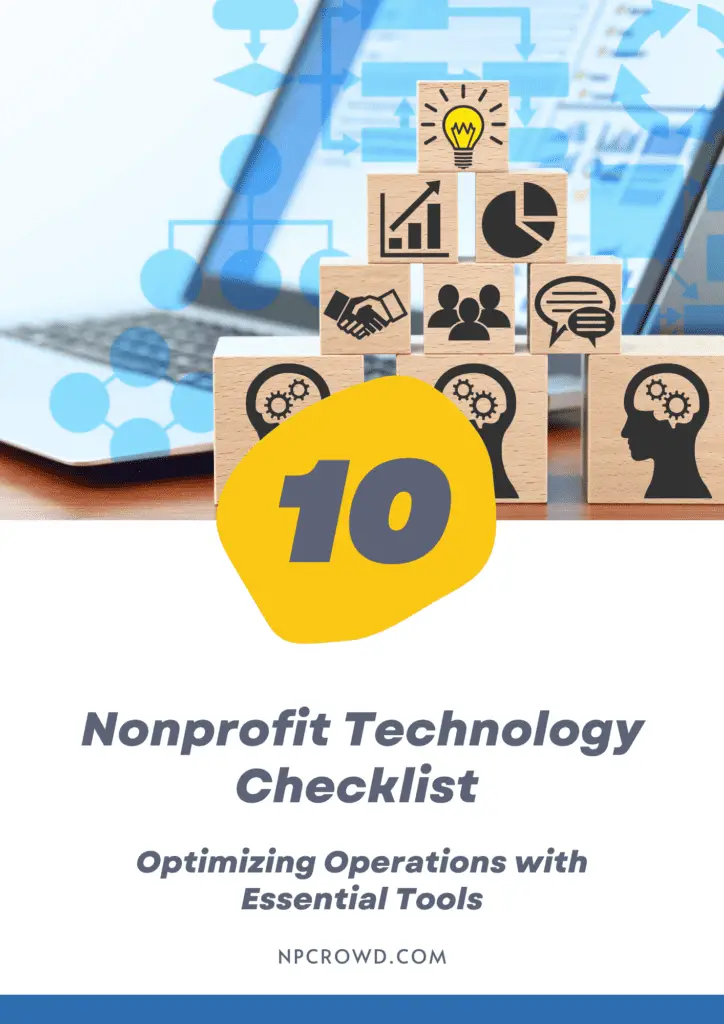How Nonprofits Work: Structure, Functions, and Typical Roles
Disclaimer: This post may contain affiliate links. These links, if used and purchases made, we may earn a small commission. These affiliate programs do not impact the recommendations we make or the resources we refer you to. Our focus is on providing you the best resources for your nonprofit journey.
Nonprofits are a type of organization that is different than for-profit organizations. Nonprofits have the goal of benefiting society in general, and they do not need to make a profit or increase equity for shareholders.To put it more succinctly, a for-profit business is financed by private investors and therefore gives equity or profit to them in turn, while nonprofits are funded by donations made by individuals, corporations, or foundations. Return on investment (ROI) from a for-profit organization has the potential to be greater although the social impact of a nonprofit will likely be greater.
There are many types of nonprofits, but we will focus on what most people think about when they hear “nonprofit.”
This article will discuss the difference between nonprofit and for-profit organizations. Then we’ll review the structure of nonprofits and typical functions and roles within a nonprofit. We’ll make a quick stop to discuss three management structures, board governance, and common board committees.
Finally, we’ll include some reasons why you may not want to become a nonprofit organization!
What is a nonprofit?
A nonprofit organization is one that does not have shareholders, profits, or equity to worry about. Nonprofits are also called “not-for-profit” organizations because the money they make goes back into their mission and can’t be distributed among owners as for-profit companies do.
Nonprofits are usually registered as corporations in the state where they operate with a specific purpose of benefiting society as a whole through charitable work.
There are many types of nonprofits besides the typical 501(c)3, such as :
- 501(c)12: A nonprofit corporation that has a specific purpose of providing business or professional organization for its members.
- 501(c)13: An organization formed to promote social welfare by organizing and conducting educational activities within the community (like churches).
- 501(c)14: This category includes organizations such as Social and recreational clubs, literary associations, business leagues or professional organizations.
- 501(c)18: This category includes religious groups like churches that function as nonprofits.
- 501(c)19: A nonprofit organization created for the benefit of a state or local government by providing goods or services exclusively to such governments (like public libraries).
How does a nonprofit work?
A nonprofit uses funds obtained from donors to carry out their work. Nonprofits are known for the tax-exempt status that comes with the donation of funds and property, but there is a lot more to it than this!
What’s important to note about nonprofits is the goal: while they may have some profit as well as equity goals like any other business, one goal must be a positive social impact, society benefit, or public good. This means that nonprofits cannot exist solely to make money or increase share value. It has charitable roots
In contrast to commercial businesses that exist primarily because of shareholder interests (shareholders want an organization that will create a return on investments), nonprofits need not focus on those things under their own set of laws.
What are the biggest differences between nonprofit and for-profit organizations?
As mentioned above, one of the biggest differences between nonprofit and for-profit organizations is that nonprofits are not created to make a profit. This means it’s up to donors to provide monetary donations in order to cover expenses.
Nonprofits can also help cover expenses by charging fees for their programs or services.
Nonprofits also have different structures than for-profit companies in order to carry out their mission without worrying about distributing equity among shareholders.
Nonprofits are usually more altruistic and are formed to make a positive social impact, while for-profit companies are usually formed to make money.
Finally, nonprofits rely heavily on volunteers while for-profit companies typically pay their employees more money than they get from grants/donations.
How are nonprofits structured?
Nonprofits are structured as a corporation in the state they operate within. This means they have to follow certain rules and guidelines for their structure, including:
- a board of directors
- officers like the president, secretary, and treasurer
- at least one director is required to be an “interested person” (which means they are on the same level as those who will benefit from the nonprofit’s work)
Nonprofit organizations also typically have one of three main structures:
- Management by Board with Executive Director/CEO (Operating Board)
- Management by CEO with Advisory Board
- Nonmanagement structure
Which type of structure your organization will use depends largely on its mission and organizational culture – all three models can work well!
Let’s dig into each type of nonprofit management structure.
Management by Board with Executive Director/CEO
This type of structure is more common in nonprofits with a small staff and/or one person who has most of the decision-making power. However, the Board makes operational decisions.
The board hires an executive director to manage day-to-day operations, which they monitor closely through regular meetings. While this may seem like too much work for volunteers, it can be effective if there are only two or three people running things at any given time.
The downside? It’s easy for disagreements between members on the board and/or the Executive Director (especially about how important particular tasks should be done) to get out of hand quickly without anyone really being able to do anything about it!
Management by CEO with Advisory Board
In this type of nonprofit, the CEO is overseeing a larger staff and has more decision-making power over overall operations. The board may act as advisory members or advisors to provide guidance on specific issues that come up like financial management, HR policies, or long-term strategy.
This structure can work well for nonprofits with many employees where there are many different tasks happening at once from fundraising/trustee relations to event planning.
Typically, the CEO is trusted to lead the organization, make most operational decisions, and recommend strategy and organizational direction.
If the CEO has a major disagreement with the board about how to operate, there may not be much that can be done about it.
The other downside? The Board doesn’t have as strong of an influence on day-to-day operations and long-term strategy as in other structures! This could also be a plus for the model.
Nonmanagement structure
This is the most democratic of nonprofits. The board and staff are all volunteers, with one person often serving as a co-chair or chairperson of the Board to coordinate operations.
In this structure, everyone has an equal voice in how decisions should be made – you may have conflicts between members about what’s most important for your organization!
The upside? You’re able to take things “one day at a time” without having to worry too much about long-term strategy because it’s not necessary when there isn’t someone else looking over your shoulder telling you what needs to get done first! It can also work well if only two people are working on day-to-day operations.
But this is also the downside of this structure. Nonmanagement organizations tend to lack vision, direction and growth, keeping nonprofits small and less well funded with less social impact.
Typical functions and roles within a nonprofit organization
Depending on the size and culture of the organization, nonprofits typically have a few key roles that are crucial to their success. For example:
Board Members (provide guidance on specific issues)
Executive Director/CEO (manages day-to-day operations)
Director(s) or Program Manager(s) for specific programs or services offered by nonprofits – these directors often oversee staff members within each program. They may also be responsible for long-term planning as well as routine operation tasks like fundraising campaigns and strategic partnerships with other organizations.
Chief Financial Officer (responsible for financial management and reporting). This person is usually in charge of managing budgets, expenses, salaries, donations received from external sources, etc.). The CFO can either work closely with an executive director or can serve as an independent consultant. The CFO is usually the person in charge of making decisions about grants and foundations but should report to the board or executive director if they are not responsible for that role themselves.
Fundraising Director/Manager (responsible for soliciting donations from other organizations, individuals, government agencies). This includes building relationships with potential donors so your nonprofit doesn’t have to rely solely on a small number of large gifts. It also means being able to identify which strategies will work best for securing funding within different areas – such as corporate giving programs over individual donor campaigns.
Nonprofit managers often juggle these multiple roles at once! In smaller nonprofits, they may be fundraising directors, program managers, and human resource directors all at the same time.
What are typical board committees in a nonprofit?
Board committees are groups of people within the board who work together to carry out specific tasks. For example, a fundraising committee might have someone in charge of invitations and greetings cards for events as well as donations from foundations.
Finance Committee – this is responsible for looking at all financial matters including budgets and grants/soliciting funding. Sometimes this committee also handles audit committee obligations.
Program Planning Committee – assists with long term planning (this includes developing organizational strategy)
Fundraising or Development Committee – handles donor relationships and donor outreach programs, campaigns, etc.). This group may also be known by other terms such as development council or fundraising council
Governance Committee – responsible for reviewing documents, providing policy input on legal matters/government regulations, and advising the board on ethical issues.
Audit Committee – reviews all financial reports and takes appropriate action if necessary. This committee is sometimes called an audit or finance review committee (ARC) but
Why you may not want to become a nonprofit organization
The nonprofit sector is the third-largest employer in this country, but it’s also the most volatile. Nonprofits are 26 times more likely to fail than for-profit businesses and nonprofits make up 99% of all charities.
- Nonprofits have been shown to grow at a rate that is slower than their counterparts because they have less funding
- According to Forbes magazine, “the average life expectancy of an organization was just 22 years”
- Nonprofits may be more complicated to run and there’s a higher risk of failure
- Nonprofit organizations have been shown to lack vision, direction, and growth. Nonprofits are often small with less social impact than their counterparts in the for-profit sector
- Nonprofit employee turnover is higher than it is within the for-profit business world.
Summary
A nonprofit is an organization that carries out the public good. Nonprofits are different from for-profit organizations because they don’t generate a profit and rely on donations to keep running.
There can be many reasons why you may not want to become a nonprofit organization: lack of vision, direction, and growth; slow rate of growth; vulnerability to failure rates amongst nonprofits.
Typical roles in a nonprofit include Executive Director/CEO who manages day-to-day operations, Directors or Program Manager(s) who oversee staff members within each program under their management, Chief Financial Officer responsible for financial management and reporting activities as well as Board Members providing guidance on specific issues such as finance, safety, and governance.







